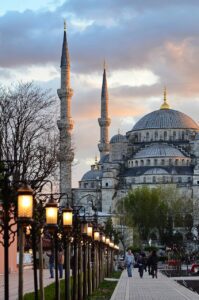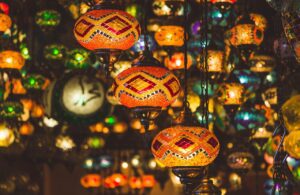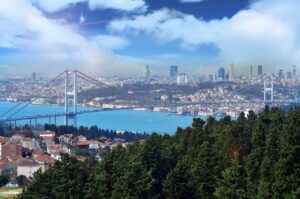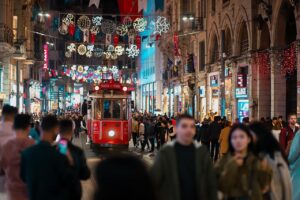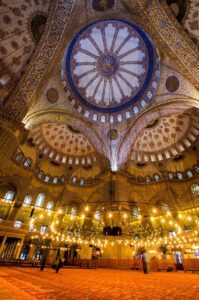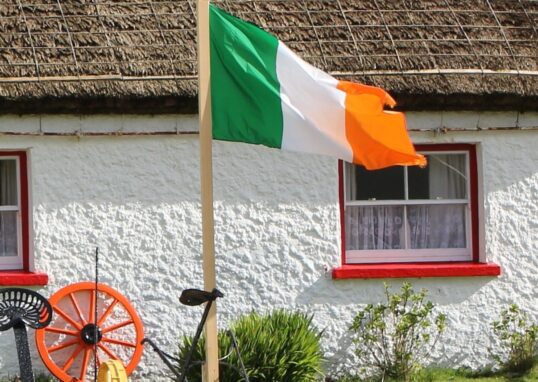
The Blue Mosque (Sultan Ahmet Mosque), Istanbul
Blue Mosque or Sultan Ahmet Mosque is one of the most renowned landmarks in Istanbul, Turkey. It is an embodiment of Islamic art, Ottoman history, and Turkish culture. Many individuals from all over the world visit this mosque every year. It is not only a praying place but a place of beauty and history as well. The Blue Mosque, as it is also known, is so named due to the numerous blue tiles located within its walls. Officially, it is known as Sultan Ahmet Mosque, after Sultan Ahmet I, who commissioned it in the early 17th century. Here, we will talk about the mosque at length. We will learn its history, architecture, and importance. We will also explore its cultural importance and its role in Istanbul today. Then we will talk about the locations surrounding it, as the mosque is in the historic city center.
History of the Blue Mosque
The Vision of Sultan Ahmet I
Sultan Ahmet had decided to build a grand mosque in Istanbul. He was adamant that it should reflect the strength and religiosity of the Ottoman Empire. Istanbul then had numerous gigantic structures like the Hagia Sophia. The Sultan thus wanted a mosque that would match, if not surpass, them in terms of looks. The construction started in 1609. The Sultan was young, in his late teens. He believed that the construction of a mosque like this would gain him fame and also benefit his people.
The Architect Sedefkâr Mehmed Agha
Sedefkâr Mehmed Agha planned the mosque. He was a student of the famous Ottoman architect Mimar Sinan. Sinan himself had already planned many grand mosques and buildings before this. Mehmed Agha learned from him and put his own flair into it. He did not want too much of tradition and too little innovation, or vice versa. The Blue Mosque was his most masterful creation.
Completion and Legacy
The mosque was finished in 1616, under the rule of Sultan Ahmet I. Unfortunately, the Sultan passed away young, just a year after the completion of the mosque. But his legacy lives on in this magnificent building. Centuries later, the Blue Mosque has become an emblem of Istanbul. It is still an operational mosque but is open to visitors of all persuasions.
Architecture of the Blue Mosque
Exterior Design
The Blue Mosque is an architectural wonder of the Ottomans. It is imposing and well-proportioned from the exterior. The mosque has:
- A gigantic central dome. Several smaller domes. Six tall minarets
The six minarets are spectacular. Most mosques have four or less. Back then, this was controversial since only the Mecca mosque had six minarets. To counter this, the Sultan ordered a seventh minaret to be built at Mecca.
The courtyard of the mosque is also very wide. It consists of marble floors, fountains, and an attractive entrance gate. The domes and minarets blend together to give the mosque its iconic skyline.
Interior Design
Inside the Blue Mosque is even more beautiful.
- Blue Tiles: Over 20,000 hand-painted ceramic tiles cover the walls. Most of them are shades of blue, hence the popular name of the mosque.
- Calligraphy: Quranic quotations are written in beautiful calligraphy. They cover arches, domes, and walls.
- Stained Glass Windows: More than 200 windows permit light to enter. The sun light is mixed with colors of the glass to create a serene glow.
- Mihrab and Minbar: The mihrab is made of fine marble. Next to it stands the minbar, from which the imam delivers sermons.
- Chandeliers: The ceiling is hung with gigantic chandeliers. Once ostrich eggs were filled with them to keep spiders at bay.
The Dome
The central dome is 23.5 meters in diameter and 43 meters high. It imparts a feeling of openness and hollowness. The small domes around it add stability and glamour.
The Courtyard
The mosque is bordered by a courtyard almost equal in size to it. It has a covering of a single arcade with domes. There is a fountain at the center. The guests walk through a magnificent entrance that adds to the sight even more.
Religious Importance
The Blue Mosque is not just a work of architecture. It is an active place of worship. Muslims pray here five times a day. The minarets summon the faithful to prayer six times daily throughout the city. For Muslims, the mosque is a summons to memory, to faith, to worship, and to beauty. For others, it is a chance to observe the union of religion and art. During Friday prayers and Islamic celebrations, the mosque is especially full. It is a bustling center of spirituality and community.
Cultural Significance
The Blue Mosque is also one of the biggest tourist spots in Istanbul. Millions visit each year. It is part of the city’s UNESCO World Heritage Site. It would be the crowning glory of Ottoman architecture. The Blue Mosque, in combination with Hagia Sophia facing it, gives a strong impression of Istanbul’s heritage. Painters, writers, and travelers have admired the mosque for centuries. The mosque is often featured in paintings, literature, and photographs.
Visiting the Blue Mosque
Entry and Dress Code
The mosque receives visitors every day, but not at the prayer time. Entrance is free. Guests who come visiting must adhere to the dressing code, however.
- Men should wear long pants. Women should cover the head using a scarf. Shoulders should be covered. Feet should be taken off before going in.
Scarves and robes are usually provided at the entrance for people who need them.
Best Time to Visit
Best time to visit is early morning or late afternoon. The light is lovely, and the crowd is less. Visits in the evening, when the mosque is illuminated, are also extremely special.
Surrounding Places Near the Blue Mosque, Sultan Ahmet Mosque
The Blue Mosque, or Sultan Ahmet Mosque, is a symbol of Istanbul. But the mosque is not alone. It sits at the heart of Sultanahmet Square, which is the epicenter of the city’s historic peninsula. Circumnavigating it are quite a number of world-famous landmarks, bazaars, museums, and cultural attractions. All of these are on foot or a short drive away. Walking through the Blue Mosque’s surroundings is equal to taking a stroll through thousands of years of history. Let us examine these surrounding sites in detail.
Hagia Sophia
Behind the Blue Mosque, and almost as prominent, stands the Hagia Sophia. This is probably the most iconic structure in Istanbul.
A History of Two Faiths
Hagia Sophia was built in 537 by the Emperor Justinian of the Byzantine Empire. It remained the largest church in Christendom for centuries. Later, when the Ottomans took over Constantinople in 1453, it was turned into a mosque. It was turned into a museum during the 20th century. Recently, it has once again been turned into a mosque.
Architecture
The Hagia Sophia boasts a gargantuan dome that seems to float in the air. The interior features Christian mosaics and Islamic calligraphy, revealing the interwoven harmony between two great civilizations.
Visitor Experience
The Hagia Sophia and the Blue Mosque are both within a two-minute walk of each other. The majority of tourists visit both in the same day. Being between the two is being between two eras of history.
Hippodrome of Constantinople
Opposite the Blue Mosque is the ancient Hippodrome. This was Constantinople’s social and sporting center during the Byzantine Empire.
Past Glory
The Hippodrome held chariot races and public events. It accommodated tens of thousands of visitors. Nothing remains now except for remnants, but they are a strong reminder of the past.
Monuments at the Hippodrome
- The Obelisk of Theodosius: An ancient Egyptian obelisk, brought to here during the 4th century.
- The Serpent Column: Delphi, Greece, where it first stood as a monument to a Greek victory against Persia.
- The German Fountain: A gift from Kaiser Wilhelm II of Germany, built in the 19th century.
Why Visit
Walking through the Hippodrome is to experience a trip back in time to the Byzantine emperors’ era. And it is only a few steps from the Blue Mosque.
Topkapi Palace
Walking a short distance from the mosque, one arrives at Topkapi Palace. This was home to Ottoman sultans for nearly 400 years.
Inside the Palace
The palace has four large courtyards. There are nice gardens, fountains, and decorated halls within. Some of the points of interest are:
- Imperial Harem: Where the family of the sultan lived.
- Treasury Room: Keeps jewels, gold items, and sacred relics.
- Council Hall: Decisions were taken here.
- Bosphorus views: The palace is constructed on a hill with stunning views.
Why Visit
Topkapi Palace shows us how the Ottoman rulers lived. It adds another perspective to the history surrounding the Blue Mosque area.
Basilica Cistern
Under the streets of Istanbul lies the Basilica Cistern. It is located very close to the Blue Mosque.
What It Is
The cistern is a 6th-century underground reservoir built by the Byzantines. It consists of 336 marble columns. The atmosphere inside is mystical and beautiful.
Famous Features
- Medusa Heads: There are two pillars that are decorated with carved-out Medusa heads.
- Lighting and Music: The cistern is not well lit, which gives it a magical feel.
Visitor Experience
It is as if one goes for a walk in an underground palace. The cold air and echoing water give it a peaceful stop.
Grand Bazaar
About a 15-minute walk from the Blue Mosque is the Grand Bazaar. It is one of the world’s largest and oldest covered bazaars.
The Market Experience
The bazaar consists of more than 4,000 shops. It has carpets, lamps, spices, ceramics, gold jewelry, and souvenirs. It is a city within the city, vibrant and colorful.
History
The bazaar started in the 15th century and grew over time. Now it remains a symbol of Istanbul’s trading culture.
Why Visit
Even if you don’t go shopping, strolling down the bazaar is an experience. The sights, aromas, and sounds are not to be forgotten.
Spice Bazaar
A little farther, but still within walking distance of the Blue Mosque, is the Spice Bazaar.
What to Expect
Less crowded than the Grand Bazaar but more of a food market, this one has the added advantage of permitting visitors to smell and sample spices, teas, dried fruits, Turkish delights, and nuts.
Local Flavor
- Spice Bazaar is the ideal place to purchase something edible as a memory of Istanbul. Archaeological Museums of Istanbul. Next to Topkapi Palace are Istanbul Archaeological Museums. They consist of three museums.
Collections
- Greek and Roman statues from ancient times. Sarcophagus of Alexander the Great. Mesopotamian and Egyptian artifacts.
Why Visit
These museums contain treasures from several ancient civilizations. They make visitors realize about the rich history of the area.
Gulhane Park
To the side of Topkapi Palace is Gulhane Park. It was previously one of the gardens of the palace.
Nature and Relaxation
Today, it is a public park with walkways, trees, and flowers. The tulips are beautiful in the spring. It is a good place to rest after walking through crowded attractions.
Bosphorus and Eminönü
From the Blue Mosque, it is a stroll to Eminönü, which is the port area. From here, there is a sight of the Bosphorus Strait.
What to Do
Go on a ferry ride across the Bosphorus. Sell fresh fish sandwiches at the pier. Observe the skyline of the city from another angle from the water.
Meaning
The Bosphorus is nature’s boundary between Europe and Asia. The boat tour here shows Istanbul from another angle.
Suleymaniye Mosque
A little closer to the Blue Mosque is the Suleymaniye Mosque. It is another Ottoman work of art.
The Architect
It was built in the 16th century by the famous architect Mimar Sinan.
Design
It is less decorated than the Blue Mosque but on a larger scale. Its location atop a hill offers panoramic views of the city.
Why Visit
It offers a counterpoint to the experience. While the Blue Mosque is drowning in decoration, Suleymaniye offers a restrained sort of beauty.
Little Hagia Sophia (Küçük Ayasofya)
Adjacent to the Blue Mosque is the Little Hagia Sophia.
It was first constructed as a church in the 6th century, for Saints Sergius and Bacchus. Subsequently, it was also used as a mosque.
Visitor Experience
It is narrower and less full, but it is very beautiful architecture. It provides a more personal experience than the larger sites.
Istanbul’s Streets and Cafés
Surrounding the Blue Mosque, there are lively streets. There are small shops selling handicrafts, Turkish coffeehouses, and restaurants serving kebabs and mezes.
Turkish Hospitality
Drinking coffee at a café and watching life pass is part of it. It helps one connect with the local culture.
Istanbul Modern and Contemporary Spots
Although the historical sites overwhelm Sultanahmet, downtown Istanbul is not a far distance away. Taking the tram or a walk into the Galata section brings people to the Galata Tower and contemporary art galleries. This juxtaposition indicates the contrast of new and old in the city.
Why the Surroundings Matter
The Blue Mosque is beautiful, but what’s around it completes it. In one small neighborhood, visitors can experience Byzantine, Ottoman, and modern Turkish life. They can pray, shop, eat, learn, and relax. Every corner has a story. The fact that they are so close together makes visitors able to see many in a single day. But staying longer makes it even more valuable.
Modern Role
The Blue Mosque is still an emblem of Istanbul. It reposes the city’s past and current. It receives pilgrims and visitors. It also serves international image, often being in movies, documentaries, and travel books.
Conclusion
The Blue Mosque, or Sultan Ahmet Mosque, is more than just a building. It is a story of religion, art, and history. From its blue ceramic tiles to its six minarets, it portrays the majesty of Ottoman architecture. Surrounded by Hagia Sophia, Topkapi Palace, the Grand Bazaar, and many other landmarks, the mosque is the star of Istanbul’s history. Visiting the Blue Mosque is not viewing a monument. It is experiencing the spirit of Istanbul. It binds the visitor to centuries of religion, culture, and beauty.

